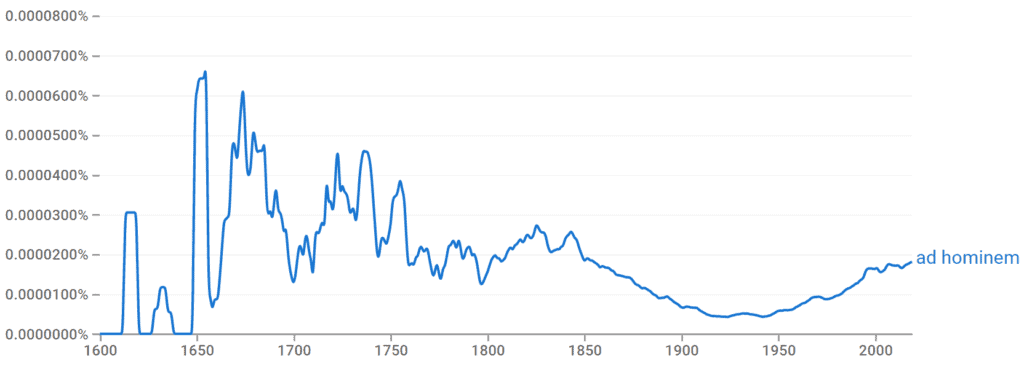The art of debate is to respectfully counter the points of an opponent’s argument with your own logical and ethical reasoning. It is never supposed to include misinformation or emotional attacks, but sometimes it is difficult to leave out personal feelings.
Unfortunately, overt emotions during debate sometimes lead to ad hominem fallacies that attack the speaker, rather than the topic. We explain this irresponsible technique and the types of ad hominem fallacies that exist below.
What is an Ad Hominem Fallacy?
Ad hominem is Latin for “to the man” and is a type of counterargument in debate. It is used to attack the personal attributes, motive, character, beliefs, or history of the person speaking, rather than the topic they are talking about.
Origin of Ad Hominem

Ad hominem use was first recorded in the 1600s. It is Latin for “to” from ad, and “man” from hominem, an accusative of homo. This translates roughly “to the interests and passions of the person” during argumentative speech or writing, and emphasizes emotion, rather than abstract truth and logic.
It works as a form of defamation against a speaker on a personal level instead of arguing against the topic.
The use of ad hominem is considered a logical fallacy. According to the Oxford Language Dictionary, a fallacy is “a mistaken belief, especially one based on unsound argument”. It creates a failure in reasoning and makes the argument invalid.
Types of Ad Hominem Fallacies
Sometimes ad hominem fallacies work alongside other types of fallacies, such as a straw man, to exaggerate emotional appeal and make it difficult to refute.
There are four main ways ad hominem is used, and recognizing what they are can help you ignore their use and stay on topic. People who use ad hominem depend on the opponent to react emotionally to these words and use them as a distraction.
Circumstantial
Argues that personal circumstances and bias are motivating a speaker’s argument, so therefore it must be false.
The Problem: It uses an unrelated event or events the speaker has experienced to negate their main points and makes assumptions about their reasons that may be untrue.
For Example:
Jennifer feels more sophomores should have an officer position in the National Honors Society at school. Jake says that’s only because her little sister is a sophomore and wants to run for office.
Abusive
Abusive ad hominem use is a personal attack on the speaker concerning their personal traits, life choices, gender, race, or religion.
The Problem: Personal and character attacks are abusive and designed to create strong emotional reactions that distract both the speaker and audience from the points being made.
For Example:
Sarah believes that every classroom should have a recycling box that the students could empty once a week. Ryan tells her it is a stupid idea because she is in a wheelchair and couldn’t even help.
Guilt by Association
This discredits the speaker due to an association with something negative, whether personal or related to their job, friends, family, religion, etc…
The Problem: This type of attack undermines the speaker’s credibility and forces the audience to question whether what they are hearing is true.
For Example:
Ian is running for class president. His opponent says he isn’t fit for the job because his younger brother was caught vandalizing the school, so Ian must not be a very good role model.
Tu Quoque
This argument uses proven past actions of the speaker to question their current argument concerning a similar topic.
The Problem: Although based on truths, past actions do not necessarily dictate what a speaker is saying is false. This is a complex fallacy to work around as it discredits the speaker using known actions and does not consider that changes may have been made.
For Example:
John appeals to the city commissioners to set aside land for a neighborhood garden to help provide fresh food. He is told he won’t know how to organize the garden because he was a High School dropout.
How Ad Hominem is Used in Media, Advertising, Literature, and the News
There are many real-life examples of ad hominem. They are seen in advertising, literature, media, and even in messages presented by trusted elected officials. These examples provide ad hominem use in a sentence to reflect where they are used in these platforms. They are used to appeal to emotion for audience reaction.
Even going ad hominem against Nick Clegg might not work, of course, but it has got to be a better bet than telling people that AV is “too complicated” or that the counting machines are “too expensive” … [Telegraph]
When discussing Jobs’ campaign against Adobe Flash, Lo dipped in an ad hominem attack. “What’s the reason for him to trash Flash? There’s no reason other than ego,” he said. [Register]
You don’t have to favor Bill’s approach to Egypt or anything else to realize an ad hominem attack without any intellectual argument is really not what conservatives should be all about. [Washington Post]
Ad hominem attacks, racial slurs, demeaning humor have no place in civilized discourse. [North Lake Tahoe Bonanza]
Let’s Review
Ad hominem fallacies are a way to take attention away from a speaker’s ideas to discredit them. It uses personal attacks based on behaviors, associations, and attributes to elicit an emotional response rather than discuss the topic using logical or ethical approaches.
The speaker and the audience should learn to recognize these types of attacks that are used to draw away from the main point in order to ignore them.
